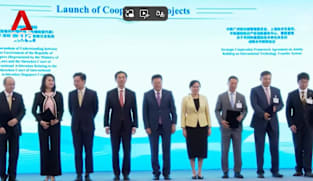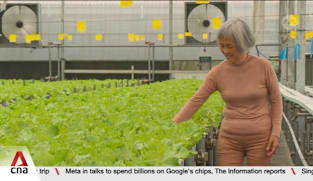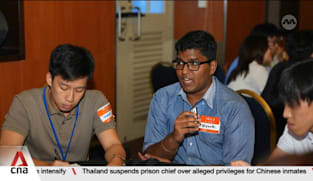Committee of Supply 2024 debate, Day 5: Tan Kiat How on partnerships to transform Singapore into City in Nature
Singapore has made good progress in transforming into a City in Nature, said Senior Minister of State for National Development Tan Kiat How. Speaking in Parliament on Tuesday (Mar 5), he outlined the key moves in the next bound by adding green spaces and enhancing existing ones. Last year, Lakeside Garden within Jurong Lake Gardens was completed. This year, the revamped Chinese and Japanese Gardens will open, thereby completing Jurong Lake Gardens. A new section of Pasir Panjang Park has opened. It is one of the 13 parks along the Southern Ridges and West Coast that will be rejuvenated. To make green spaces more accessible and inclusive, the Government is on track to achieve its goal of 30 therapeutic gardens by 2030, having launched 14 so far. It is strengthening the connectivity between green spaces, having established around 210km of Nature Ways and more than 380km of park connectors, including the first phase of the Round Island Route. Nature is being restored in the urban fabric to safeguard biodiversity. Last year alone, almost 40 hectares of skyrise greenery were added for a total of 190 hectares - the equivalent of more than 270 football fields. Mr Tan said the Government is close to achieving its target of 200 hectares by 2030. It has also restored and enhanced more than 40 hectares of forest, coastal and marine habitats. It is halfway to meeting its enhanced target of 80 hectares by 2030. The Sisters’ Islands Marine Park is being enhanced and Big Sister’s Island will reopen to the public this year, with a new coastal forest trail, tidal lagoon and specially designed subtidal biodiversity panels along the floating boardwalk for visitors to observe marine life with minimal impact on the ecosystem. Mr Tan stressed the need to develop sensitively and sustainably, saying the Government has been strengthening the Environmental Impact Assessment (EIA) process. For example, it published detailed guidelines for biodiversity impact assessments and is piloting the centralised management of EIA consultancy services under NParks. The Government is also working with agencies and institutions to enhance biosurveillance. Mr Tan said biosurveillance is a crucial line of defence against zoonotic disease outbreaks. The Government will step up research with a new S$15 million Biosurveillance Research Programme to harness expertise and emerging technologies across multiple disciplines. Researchers can look forward to grant calls later this year. Turning to animal cruelty, Mr Tan said the Government is looking at the possibility of enhancing the penalties - from protections for animal health and welfare to stronger safeguards on public health and safety. Concluding, Mr Tan stressed the need for partnerships in transforming Singapore into a City in Nature. “We have made good progress, but there is more to be done. As we press on with our efforts, we will continue to collaborate with stakeholders and the wider community. Together, we can shape a green, vibrant and resilient Singapore that we are all proud to call home,” he said.
Singapore has made good progress in transforming into a City in Nature, said Senior Minister of State for National Development Tan Kiat How. Speaking in Parliament on Tuesday (Mar 5), he outlined the key moves in the next bound by adding green spaces and enhancing existing ones. Last year, Lakeside Garden within Jurong Lake Gardens was completed. This year, the revamped Chinese and Japanese Gardens will open, thereby completing Jurong Lake Gardens. A new section of Pasir Panjang Park has opened. It is one of the 13 parks along the Southern Ridges and West Coast that will be rejuvenated. To make green spaces more accessible and inclusive, the Government is on track to achieve its goal of 30 therapeutic gardens by 2030, having launched 14 so far. It is strengthening the connectivity between green spaces, having established around 210km of Nature Ways and more than 380km of park connectors, including the first phase of the Round Island Route. Nature is being restored in the urban fabric to safeguard biodiversity. Last year alone, almost 40 hectares of skyrise greenery were added for a total of 190 hectares - the equivalent of more than 270 football fields. Mr Tan said the Government is close to achieving its target of 200 hectares by 2030. It has also restored and enhanced more than 40 hectares of forest, coastal and marine habitats. It is halfway to meeting its enhanced target of 80 hectares by 2030. The Sisters’ Islands Marine Park is being enhanced and Big Sister’s Island will reopen to the public this year, with a new coastal forest trail, tidal lagoon and specially designed subtidal biodiversity panels along the floating boardwalk for visitors to observe marine life with minimal impact on the ecosystem. Mr Tan stressed the need to develop sensitively and sustainably, saying the Government has been strengthening the Environmental Impact Assessment (EIA) process. For example, it published detailed guidelines for biodiversity impact assessments and is piloting the centralised management of EIA consultancy services under NParks. The Government is also working with agencies and institutions to enhance biosurveillance. Mr Tan said biosurveillance is a crucial line of defence against zoonotic disease outbreaks. The Government will step up research with a new S$15 million Biosurveillance Research Programme to harness expertise and emerging technologies across multiple disciplines. Researchers can look forward to grant calls later this year. Turning to animal cruelty, Mr Tan said the Government is looking at the possibility of enhancing the penalties - from protections for animal health and welfare to stronger safeguards on public health and safety. Concluding, Mr Tan stressed the need for partnerships in transforming Singapore into a City in Nature. “We have made good progress, but there is more to be done. As we press on with our efforts, we will continue to collaborate with stakeholders and the wider community. Together, we can shape a green, vibrant and resilient Singapore that we are all proud to call home,” he said.



















